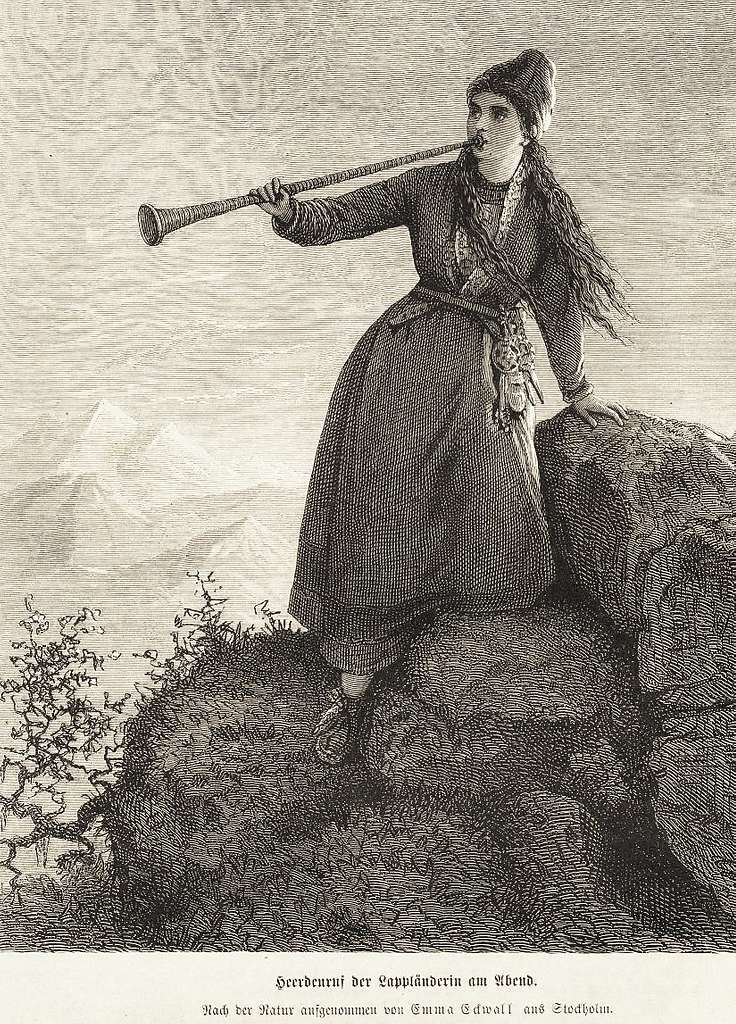Einar Selvik brings back traditional Nordic style of creating music.
Do you know what it's like to have goosebumps linger for days?
The Wardruna concert in Salt Lake City had been completely sold out for months, and I missed getting tickets. So, when my professor told me on the day of the concert that Wardruna’s lead singer would be at the JFSB for a lecture, I was ecstatic. I followed him down the hall after class to the auditorium where we joined other folk fans, metal maniacs, Scandinavian scholars, and Norse nerds for a spine-tingling spiritual experience with academics, music, and the famous Einar Selvik on November 7, 2022.
Assistant Professor Mike Pope (Latin Epic Poetry) and Associate Professor Nate Kramer (Scandinavian Studies) brought Einar Selvik of the Norse music group Wardruna to BYU for a Scandinavian Club lecture. Even though he was at the tail end of Wardruna’s 2022 US tour, Selvik generously agreed to visit and teach about his folk music. Selvik spoke about studying and creating Nordic folk music with influence from traditional instruments, poetry, and spirituality.
The Project
As the main composer and initiator of Wardruna, Selvik often gives lectures about the band and the significance of their goal to educate audiences on ancient Scandinavian music. After live performances (which are more similar in nature to attending the symphony than a typical folk-rock concert), he will often remain on stage to educate, answer questions, and lecture on the music. He has also been known to visit other schools to do the same thing, sans band.
Professor Pope, knowing this and having personally witnessed Selvik as a fantastic orator at a Red Rocks concert, was eager to have him visit BYU and speak to the Scandinavian Club. Pope conscripted fellow music fan and Norwegian and Danish speaker Professor Kramer to invite Selvik to come teach about his project.

Not just a band focused on musical entertainment, Wardruna crafts music to educate and to connect. Their website explains, “Thorough research and serious study form an important foundation for our music, but the ultimate intention is not to copy or recreate music from any specific time period. We take thoughts, tools and methods from the past and use them to create new music which builds on the contemporary as well as the ancient.”
The name Wardruna further illustrates their mission. Selvik explained that Wardruna means guardian of runes, or warden of runes, with runes meaning “sounds,” “whispers,” “symbols,” and “magic.” Selvik said that he chose the theme of runes because “they tell the story of man’s relationship to nature, to each other, and to something that is bigger than ourselves.” That is what the music is about. Selvik combines scholarship and academia with his own skill and knowledge about music, poetry, and heritage to create ancient-inspired music that connects us to the past, to each other, and to nature.
The Lecture
Some scholars say that it isn’t possible to know what music might have sounded like in the Viking age. Selvik tends to disagree. He explained that there are things that give us strong indications of how music might have sounded. The instruments and poems themselves, for one, “show us how to find the voices of the time.”

Instruments
Selvik brought a handful of instruments with him, including a goat horn, a lur, and a lyre, and he demonstrated each after explaining what scholars know about their origins, what they are made of, and how they were used—and how they are currently used, for those that still have a living tradition. His own expansive knowledge of instruments and passion for playing music, combined with the academic, historical study of these various ancient instruments, brought them to life in an intimate way.
Poetry
Selvik studies Old Norse poetry as diligently as he studies Norse instruments. Poetry (especially when combined with the horn or the lyre) helps us understand tonalities and rhythms. If a poem is written in a specific meter, then you know a particular beat and melody works. Selvik explained, “Some meters are clearly more suited to singing than others.” Commenting on singing poems, Selvik said, “Poetry speaks to us because it has layers of things that are timeless and still relevant.” In the musical decisions Selvik makes as he composes, he tries to lean into those timeless themes like nature and animism rather than trying to copy the music from any specific time period.
Selvik told the audience that one of his guides for creating and performing music is “becoming [the music] so that it comes from somewhere real. If you want it to pierce the heart, it needs to come from the heart.” As he ended his lecture, Selvik spoke about the spiritual connection between humans and nature, both past and present. He said, “Once, it was cultivated nature that was sacred. Now the world has become so cultivated that wild nature is sacred. They have switched. That’s why applying old into the new would never work. But we should learn from the past.”
The Impact
So, those goosebumps I mentioned? Yeah, I’m not exaggerating. And I wasn’t the only one.

In the days following the event, I caught up with Pope and Kramer to get their thoughts on the success of Selvik’s visit. It was everything they had hoped for and more. Commenting on Selvik’s presentation, Pope expresses that he “felt such a connection to Selvik’s project of not living in the past, but of making these beautiful things that survive meaningful in the present.”
Kramer says he could feel a “deep spiritual devotion” as Selvik spoke and performed—especially regarding nature as a spiritual resource. He explains, “You sense that kind of spirituality in his music. This wasn’t merely entertainment for him or a subject of interest or a way to make money. That was an expression of personal belief. He definitely brought his own kind of spiritual experience to us.”
Kramer also comments on the combination of performance and academics, saying, “Selvik sees that performing music is its own way of understanding how the Vikings may have done their music. Academic understanding can only get us so far. The actual performance of an instrument, or seeing how an instrument was played, adds a whole new dimension to understanding what music was like.” Pope further adds, “Selvik is part of the conversation. He’s adding to it. He’s not just a musician. He’s not just a bard who’s grading poetry. He’s not just an academic. He’s combining them all together.”
Selvik’s visit to BYU helped Kramer, Pope, and the Scandinavian Club understand the rich spirituality behind Norse music. Kramer compliments Selvik, saying the lecture “exceeded all of our expectations.” Pope says, “he was extremely generous with his time and personal convictions.” He and Pope each express great gratitude for Selvik’s willingness to come to BYU. They, and the whole Scandinavian Club, hope Selvik and Wardruna return to Utah, and to BYU, in the future.
Scandinavia on BYU Campus
If you are interested in Vikings, Norse poetry, Scandinavian history, and more, there are multiple classes available in the Scandinavian studies program, housed in the Comparative Arts & Letters Department of the College of Humanities. Everybody is also welcome to attend Scandinavian Club events where lovers of all things Nordic watch topical movies, play board games about Vikings, host lectures like this one, and enjoy a variety of other events. Find a calendar of events on the club website. If you felt inspired by Wardruna and want to follow the project, you can find them on their website and on social media.